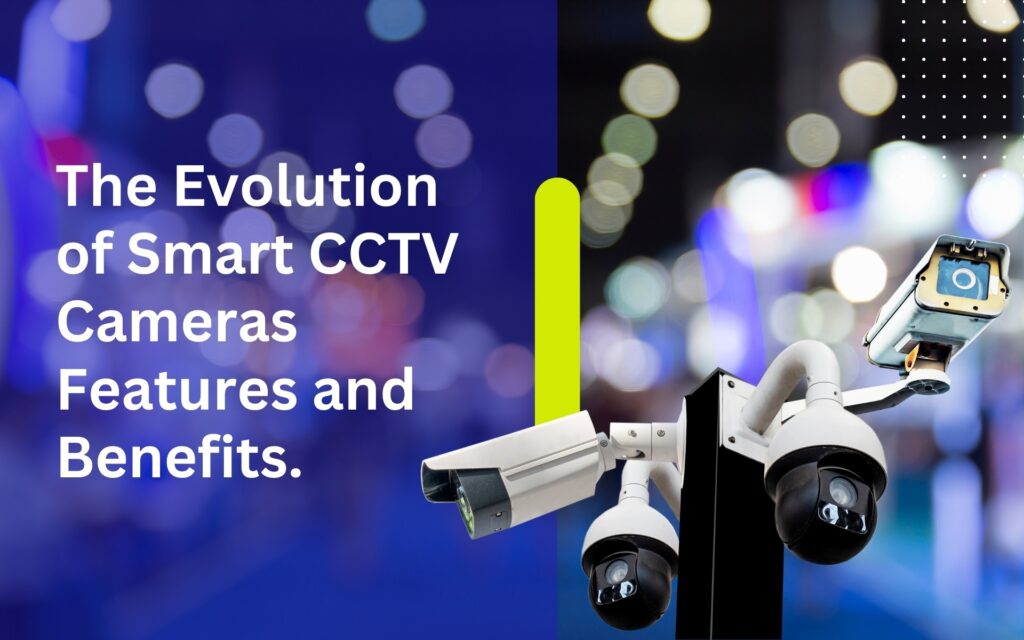Celebrating a Year of Growth and Success at InstallersPH IT Solutions. Introduction. As the year comes to a close, InstallersPH IT Solutions takes a moment to reflect on a journey defined by …
The Evolution of Smart CCTV Cameras Features and Benefits.

Introduction
The evolution of Closed-Circuit Television (CCTV) cameras has been nothing short of revolutionary, reshaping the landscape of security surveillance. From the rudimentary analog systems of the past to the sophisticated smart CCTV cameras of today, the journey has been marked by continual innovation and technological advancement. In this comprehensive exploration, we delve into the evolutionary trajectory of smart CCTV cameras, examining their features, benefits, and the profound impact they have on modern security solutions.
Evolution of Smart CCTV Cameras: A Historical Perspective
1. Analog Era: Laying the Foundation
The inception of CCTV surveillance can be traced back to the analog era, where early systems relied on bulky cameras and VCRs for recording.
Despite their limitations in resolution and functionality, analog CCTV cameras served as the cornerstone of security systems, providing a semblance of monitoring and deterrence.
2. Transition to Digital: Enhancing Capabilities
The advent of digital technology marked a significant leap forward in the realm of surveillance.
Digital CCTV cameras offered improved image quality, greater storage capacity, and enhanced connectivity options.
The introduction of Digital Video Recorders (DVRs) revolutionized data storage, enabling longer recording times and easier access to archived footage.
3. Emergence of IP Cameras: Connectivity and Integration
Internet Protocol (IP) cameras emerged as a game-changer in the surveillance industry, leveraging network connectivity for data transmission.
With higher resolutions and advanced features, IP cameras paved the way for remote monitoring and centralized management.
Power over Ethernet (PoE) technology simplified installation and reduced infrastructure costs, making IP cameras more accessible to a broader range of users.
4. Smart CCTV Cameras: Intelligence Redefined
The evolution of smart CCTV cameras represents the convergence of cutting-edge technologies, including Artificial Intelligence (AI) and Machine Learning (ML).
By harnessing the power of AI algorithms, smart cameras are capable of autonomous decision-making and real-time analysis of video feeds.
Advanced video analytics enable features such as facial recognition, object detection, and behavioral analysis, transforming CCTV cameras into proactive security tools.
Features of Smart CCTV Cameras: Unlocking the Potential
1. High-Definition Imaging:
Smart CCTV cameras boast higher resolutions and improved image sensors, delivering crystal-clear footage for enhanced surveillance and identification purposes.
High dynamic range (HDR) technology ensures optimal image quality, even in challenging lighting conditions.
2. Remote Monitoring and Management:
With built-in network connectivity, smart CCTV cameras enable remote access to live video feeds and archived footage.
Users can monitor multiple cameras from a centralized interface, facilitating real-time surveillance and proactive incident response.
3. Motion Detection and Tracking:
Smart CCTV cameras leverage motion detection algorithms to identify and track moving objects within their field of view.
Automated alerts and notifications notify users of suspicious activities, enabling timely intervention and threat mitigation.
4. Night Vision Capabilities:
Infrared (IR) LEDs and low-light image sensors enable smart CCTV cameras to capture clear footage in low-light or nighttime conditions.
Enhanced night vision capabilities extend the surveillance coverage, ensuring round-the-clock security monitoring.
5. Two-Way Audio Communication:
Some smart CCTV cameras feature built-in microphones and speakers, allowing for two-way audio communication between operators and individuals within the camera’s vicinity.
This feature facilitates remote interaction and verbal warnings, enhancing situational awareness and deterrence capabilities.
6. Intelligent Video Analytics:
Smart CCTV cameras employ advanced video analytics algorithms to analyze video feeds in real-time.
Features such as facial recognition, license plate recognition, and object classification enable automated identification and alerting for specific events or anomalies.
7. Edge Storage and Cloud Integration:
Smart CCTV cameras offer flexible storage options, including onboard storage (edge storage) and cloud-based storage solutions.
Edge storage provides local recording capabilities, ensuring continuous operation and data redundancy in the event of network connectivity issues.
Cloud integration enables seamless access to archived footage from any location with internet connectivity, enhancing scalability and data accessibility.
Benefits of Smart CCTV Cameras: Empowering Security Solutions
1. Enhanced Security and Threat Detection:
Smart CCTV cameras enhance security by providing real-time monitoring, threat detection, and rapid response capabilities.
Advanced features such as facial recognition and object detection enable proactive threat identification, deterring potential intruders and criminal activities.
2. Crime Prevention and Deterrence:
The presence of smart CCTV cameras acts as a visible deterrent to criminal behavior, reducing the likelihood of vandalism, theft, and other security incidents.
Studies have shown that the installation of CCTV cameras can lead to a significant decrease in crime rates in monitored areas.
3. Operational Efficiency and Resource Optimization:
Smart CCTV cameras streamline security operations by automating surveillance tasks and reducing the need for manual monitoring.
Automated alerts and notifications enable security personnel to prioritize and respond to critical incidents promptly, optimizing resource allocation and operational efficiency.
4. Scalability and Future-Proofing:
Smart CCTV systems are inherently scalable, allowing users to expand their surveillance infrastructure as their needs evolve.
Modular design and interoperability with other security systems ensure compatibility and future-proofing, protecting investments against obsolescence.
5. Legal Compliance and Evidence Collection:
Smart CCTV cameras assist organizations in meeting regulatory requirements and legal obligations related to security and surveillance.
High-quality footage captured by smart cameras serves as valuable evidence in investigations, prosecutions, and insurance claims, bolstering accountability and liability protection.
6. Remote Accessibility and Flexibility:
The remote access capabilities of smart CCTV cameras empower users to monitor their premises from anywhere, at any time.
Mobile apps and web-based interfaces enable users to view live video feeds, playback recorded footage, and adjust camera settings remotely, enhancing flexibility and convenience.
7. Cost-Effectiveness and Return on Investment (ROI):
While the initial investment in smart CCTV systems may be higher than traditional surveillance solutions, the long-term benefits justify the cost.
By reducing security risks, minimizing losses, and enhancing operational efficiency, smart CCTV cameras deliver a compelling return on investment over time.
Implications for Modern Security Solutions: Embracing Innovation
The evolution of smart CCTV cameras has profound implications for modern security solutions, driving innovation and transformation across various industries and sectors. As organizations strive to safeguard their assets, protect their personnel, and mitigate security risks, smart CCTV systems emerge as indispensable tools in their security arsenal.
1. Integration with IoT and Smart Building Technologies:
Smart CCTV cameras are increasingly integrated with Internet of Things (IoT) devices and smart building technologies to create interconnected security ecosystems.
Integration with access control systems, intrusion detection systems, and building automation systems enhances situational awareness and enables holistic security management.
2. Adoption of Artificial Intelligence and Predictive Analytics:
The adoption of artificial intelligence (AI) and predictive analytics enables smart CCTV cameras to go beyond reactive surveillance and anticipate security threats.
Predictive algorithms analyze historical data patterns to identify potential security vulnerabilities and preemptively mitigate risks before they escalate.
3. Privacy and Ethical Considerations:
The deployment of smart CCTV cameras raises concerns related to privacy, data protection, and ethical use of surveillance technologies.
Organizations must implement robust privacy policies, data encryption mechanisms, and access controls to safeguard sensitive information and comply with regulatory requirements.
4. Collaboration and Information Sharing:
Collaboration and information sharing between public and private stakeholders play a crucial role in maximizing the effectiveness of smart CCTV systems.
Public-private partnerships, industry collaborations, and information-sharing initiatives enhance situational awareness, intelligence gathering, and threat mitigation efforts.
Conclusion
In conclusion, the evolution of smart CCTV cameras represents a transformative shift in the field of security surveillance, empowering organizations with advanced capabilities to protect their assets, mitigate risks, and ensure public safety. From high-definition imaging and intelligent video analytics to remote monitoring and proactive threat detection, smart CCTV systems offer a comprehensive solution for modern security challenges.
As technology continues to evolve and threats become more sophisticated, the adoption of smart CCTV cameras will become increasingly vital for organizations seeking to stay ahead of the curve. By embracing innovation, investing in robust security solutions, and prioritizing proactive risk management strategies, businesses, governments, and communities can create safer and more secure environments for all stakeholders.
Related Articles
Notice to the Public: Holiday Vacation Advisory of InstallersPH IT Solutions. Introduction. InstallersPH IT Solutions is committed to providing reliable and professional IT services to all our valued clients and partners. As …
The On-the-Job Training Experience of Sherlyn Linao. Introduction On-the-Job Training (OJT) is an essential part of a student’s academic development, providing practical exposure to real workplace environments. It allows interns to apply …



